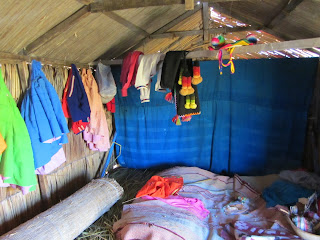31 August 2013
LAKE TITICACA, PERU
Across the middle of the picture you can see the line of huts on the islands.
The "tortora" reed is a cattail type rush growing native in the lake.
The lake is only about 6 to 10 feet deep where the islands are anchored.
The island is built up on top of...
several massive chucks of matted roots of the reeds (much larger than these shown and about 3 feet thick) which are cut from the coastal areas of the lake and then dragged to where the new island will be and are anchored to the lake bottom.
Once the base is in place, up to 10 feet of fresh reeds are layered on top.
The base of the reed near the root is the most buoyant so it is laid out criss-cross style
to create the "floating" island.
It can also be eaten. I thought is was like a softer celery.
The top of the reeds are dried to make rope, baskets and thatched roofing.
Islands average between 60 to 120 feet in length. They only last about 30 years.
Two to ten families live on each island. When it's time for the married children to go off on their own, they just cut off a piece of the island and drag it off to another part of the lake and set anchor.

Each island has a president. It is usually a woman because the men are always out fishing.

This view shows a little more than half the width of the island.
The island doesn't feel like you are on a rocking raft but the reeds are "spongy" under your feet.
Tapestries explain some of their history and culture.
Personal belongs are minimal.
When the island deteriorates and needs to be built up with more reeds,
8 or 10 people just pick up the house, set it down somewhere else,
add reeds and then put the house back.

The sale of handicrafts supplement their income.

As we left the island they sang several songs for us.

No motors on these beauties!
Notice the solar panels. These are for recharging their cell phones and running their TV's...
but no microwaves. Yes, they still cook this way...it is their only option.
We liked the islands so much we went back the next day for Church.
Each island has a name.
The Mormon Church and some of the Church members are on Apu Inti island.
Some just walk to the back of their island to go to Church.
Others come by boat.
Second from right is the Primary President.
The little boy in the white tuxedo (with tails) is named Josue Bednar, obviously after Elder David Bednar, one of the modern day apostles of Jesus Christ.
Classrooms
Primary
Young Men & Young Women
Inside the chapel.
Just as soft as the couches in most church foyers.


































1 comment:
That is fascinating! Thank you for sharing your explorations! I love to see what opportunities you guys take advantage of. So cool!
Post a Comment